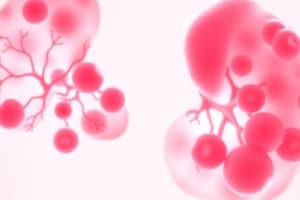Podcast
Questions and Answers
Which of the following is the most common site for lymph node enlargement in Hodgkin Disease?
Which of the following is the most common site for lymph node enlargement in Hodgkin Disease?
- Nodes below the diaphragm
- Cervical nodes (correct)
- Inguinal nodes
- Bone marrow
What does the 'B' modifying characteristic refer to in the Ann Arbor staging system?
What does the 'B' modifying characteristic refer to in the Ann Arbor staging system?
Symptoms present at time of staging
Localized tumors are most commonly treated with ______ therapy.
Localized tumors are most commonly treated with ______ therapy.
radiation
Which of the following best describes leukemias?
Which of the following best describes leukemias?
Lymphomas are characterized by their tendency to remain localized in lymph tissues and are rarely disseminated at diagnosis.
Lymphomas are characterized by their tendency to remain localized in lymph tissues and are rarely disseminated at diagnosis.
What is the primary cell type that undergoes malignant transformation in plasma cell myeloma?
What is the primary cell type that undergoes malignant transformation in plasma cell myeloma?
The myeloid lineage includes red blood cells, platelets, monocytes, and __________.
The myeloid lineage includes red blood cells, platelets, monocytes, and __________.
Which category of hematologic neoplasms includes B cells, T cells, and natural killer (NK) cells?
Which category of hematologic neoplasms includes B cells, T cells, and natural killer (NK) cells?
Match the following characteristics with the correct type of malignant disorder:
Match the following characteristics with the correct type of malignant disorder:
In hematologic neoplasms, the classification is based on the _____ of the neoplasm.
In hematologic neoplasms, the classification is based on the _____ of the neoplasm.
What is the optimal initial therapy for Plasma Cell Myeloma?
What is the optimal initial therapy for Plasma Cell Myeloma?
Hodgkin disease is more common in females and also has a worse prognosis for them.
Hodgkin disease is more common in females and also has a worse prognosis for them.
What type of cells characterize Hodgkin disease?
What type of cells characterize Hodgkin disease?
Hodgkin disease usually metastasizes along contiguous __________ pathways.
Hodgkin disease usually metastasizes along contiguous __________ pathways.
Approximately what percentage of malignant lymphomas does Hodgkin disease represent?
Approximately what percentage of malignant lymphomas does Hodgkin disease represent?
The histologic pattern of Hodgkin disease is a strong predictor of prognosis.
The histologic pattern of Hodgkin disease is a strong predictor of prognosis.
What virus is frequently found in the genome of transformed Reed–Sternberg cells?
What virus is frequently found in the genome of transformed Reed–Sternberg cells?
The classical type of Hodgkin disease accounts for approximately _____ % of diagnoses.
The classical type of Hodgkin disease accounts for approximately _____ % of diagnoses.
What is the overall 5-year survival rate for all stages of treated Hodgkin disease?
What is the overall 5-year survival rate for all stages of treated Hodgkin disease?
What is a characteristic of malignant plasma cells in multiple myeloma?
What is a characteristic of malignant plasma cells in multiple myeloma?
Bence Jones proteins are heavy-chain antibody fragments.
Bence Jones proteins are heavy-chain antibody fragments.
What is the typical range of plasma cell occupation in bone marrow that confirms a diagnosis of multiple myeloma?
What is the typical range of plasma cell occupation in bone marrow that confirms a diagnosis of multiple myeloma?
The accumulation of Bence Jones proteins in the blood and urine can help to _________ the diagnosis of multiple myeloma.
The accumulation of Bence Jones proteins in the blood and urine can help to _________ the diagnosis of multiple myeloma.
Match the following diagnostic findings with their clinical implications in multiple myeloma:
Match the following diagnostic findings with their clinical implications in multiple myeloma:
What is a common consequence of bone destruction in multiple myeloma?
What is a common consequence of bone destruction in multiple myeloma?
Malignant plasma cells typically accumulate in the bloodstream, not in the bone.
Malignant plasma cells typically accumulate in the bloodstream, not in the bone.
What specific test is used to detect monoclonal antibodies in the bloodstream?
What specific test is used to detect monoclonal antibodies in the bloodstream?
Pathological fractures are a common complication in multiple myeloma due to the accumulation of malignant plasma cells in the ________.
Pathological fractures are a common complication in multiple myeloma due to the accumulation of malignant plasma cells in the ________.
What is the premalignant stage of plasma cell myeloma called?
What is the premalignant stage of plasma cell myeloma called?
Bone pain is often the first symptom of plasma cell myeloma.
Bone pain is often the first symptom of plasma cell myeloma.
What percentage of individuals with MGUS progress to a malignant plasma cell disease?
What percentage of individuals with MGUS progress to a malignant plasma cell disease?
Multiple myeloma diagnosis may occur when routine examination reveals high ______ levels.
Multiple myeloma diagnosis may occur when routine examination reveals high ______ levels.
What is one common characteristic of bone involvement in plasma cell myeloma as seen on X-rays?
What is one common characteristic of bone involvement in plasma cell myeloma as seen on X-rays?
Autologous stem cell transplantation is not a considered treatment for plasma cell myeloma.
Autologous stem cell transplantation is not a considered treatment for plasma cell myeloma.
Which of the following is NOT typically associated with bone marrow depression in multiple myeloma?
Which of the following is NOT typically associated with bone marrow depression in multiple myeloma?
What is a major contributing factor to renal insufficiency in multiple myeloma?
What is a major contributing factor to renal insufficiency in multiple myeloma?
The presence of _______ in urine is a potential diagnostic indicator of plasma cell myeloma.
The presence of _______ in urine is a potential diagnostic indicator of plasma cell myeloma.
Match the following factors with their potential association to renal complications in multiple myeloma:
Match the following factors with their potential association to renal complications in multiple myeloma:
Flashcards
Types of leukemia
Types of leukemia
Types of leukemia differ based on malignant transformation processes.
Acute vs Chronic leukemia
Acute vs Chronic leukemia
Acute leukemia progresses quickly; chronic leukemia develops slowly.
Bone marrow depression
Bone marrow depression
Malignant disorders of white blood cells lead to decreased bone marrow function.
Hodgkin disease
Hodgkin disease
Signup and view all the flashcards
Staging of lymphomas
Staging of lymphomas
Signup and view all the flashcards
Plasma cell myeloma
Plasma cell myeloma
Signup and view all the flashcards
Hematologic neoplasms classification
Hematologic neoplasms classification
Signup and view all the flashcards
Monoclonal Antibodies
Monoclonal Antibodies
Signup and view all the flashcards
Bence Jones Protein
Bence Jones Protein
Signup and view all the flashcards
Hypercalcemia
Hypercalcemia
Signup and view all the flashcards
Bone Lesions
Bone Lesions
Signup and view all the flashcards
Serum Protein Electrophoresis
Serum Protein Electrophoresis
Signup and view all the flashcards
Pathological Fractures
Pathological Fractures
Signup and view all the flashcards
Bone Marrow Biopsy
Bone Marrow Biopsy
Signup and view all the flashcards
Plasma Cell Accumulation
Plasma Cell Accumulation
Signup and view all the flashcards
Asymptomatic early stages
Asymptomatic early stages
Signup and view all the flashcards
Painless lymphadenopathy
Painless lymphadenopathy
Signup and view all the flashcards
Ann Arbor staging system
Ann Arbor staging system
Signup and view all the flashcards
Stage A vs Stage B
Stage A vs Stage B
Signup and view all the flashcards
Localized vs Disseminated disease
Localized vs Disseminated disease
Signup and view all the flashcards
Monoclonal Gammopathy of Undetermined Significance (MGUS)
Monoclonal Gammopathy of Undetermined Significance (MGUS)
Signup and view all the flashcards
Asymptomatic Phase of MGUS
Asymptomatic Phase of MGUS
Signup and view all the flashcards
Routes of Diagnosis for Myeloma
Routes of Diagnosis for Myeloma
Signup and view all the flashcards
First Symptom of Multiple Myeloma
First Symptom of Multiple Myeloma
Signup and view all the flashcards
Bone Marrow Depression Indicators
Bone Marrow Depression Indicators
Signup and view all the flashcards
Renal Insufficiency in Myeloma
Renal Insufficiency in Myeloma
Signup and view all the flashcards
Honeycomb Appearance on X-Ray
Honeycomb Appearance on X-Ray
Signup and view all the flashcards
Prognosis for Multiple Myeloma
Prognosis for Multiple Myeloma
Signup and view all the flashcards
Stem Cell Transplantation
Stem Cell Transplantation
Signup and view all the flashcards
Autologous stem cell transplant
Autologous stem cell transplant
Signup and view all the flashcards
Renal dysfunction treatment
Renal dysfunction treatment
Signup and view all the flashcards
Narcotic pain relievers
Narcotic pain relievers
Signup and view all the flashcards
Reed–Sternberg cells
Reed–Sternberg cells
Signup and view all the flashcards
Epstein–Barr virus
Epstein–Barr virus
Signup and view all the flashcards
5-year survival rate
5-year survival rate
Signup and view all the flashcards
Classical Hodgkin Disease
Classical Hodgkin Disease
Signup and view all the flashcards
Lymphocyte predominance type
Lymphocyte predominance type
Signup and view all the flashcards




